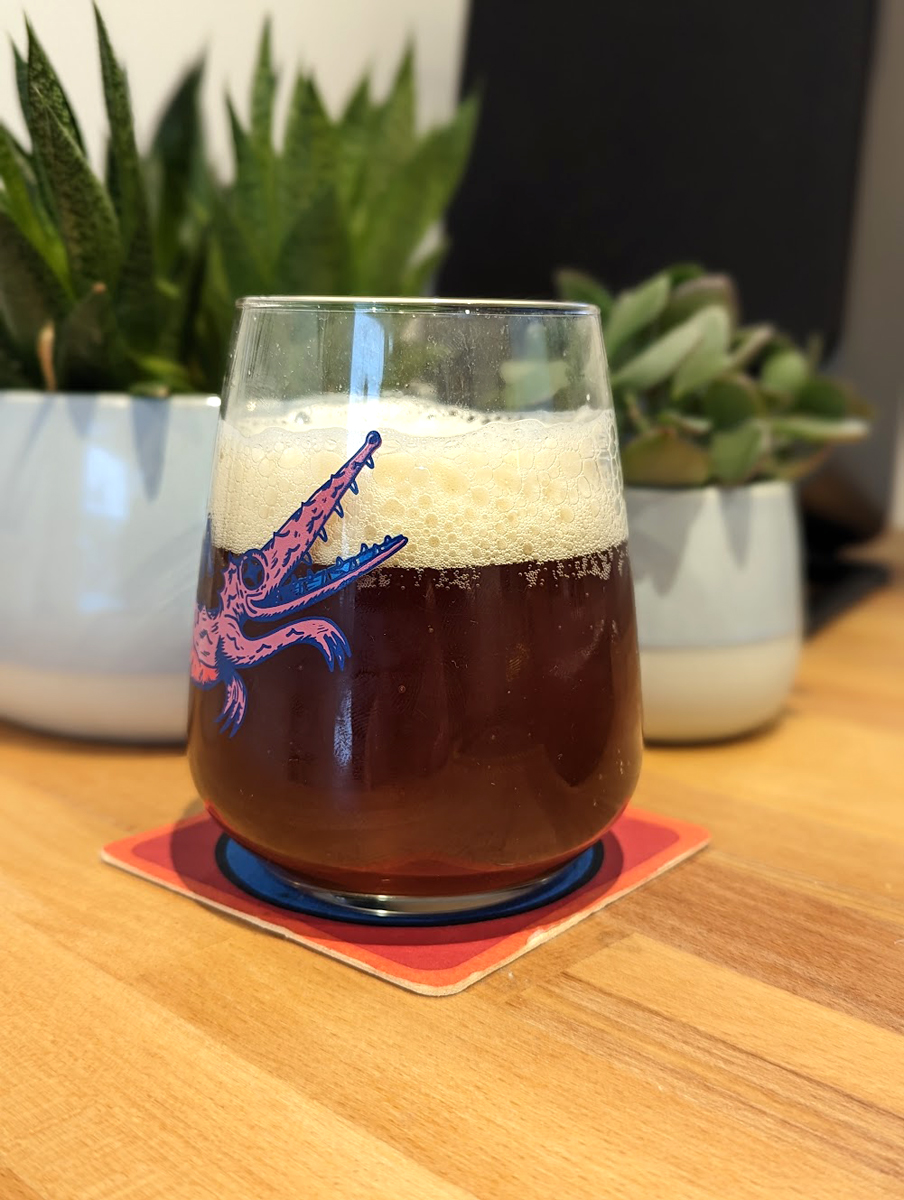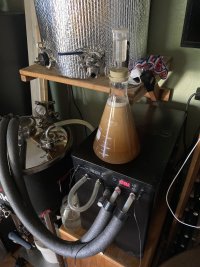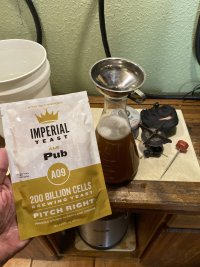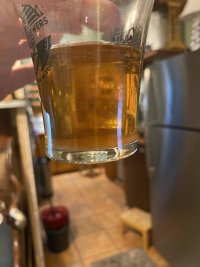The yeast is not actively swimming around, the turbulances keeping the yeast in suspension are generated by rising bubbles of co2. This force impacts dead and living cells the same way. Yeasts that clump togehter, ie. flocculate can build up bigger mass per particle, this means they settle down and do not get affected by the currents as much as single cells. Therefore, dead cells do not sink more often to the bottom than living cells, meaning by decanting off the mass at the bottom, you are removing the best flocculators, not the dead cells.I would think that the short time between the transfer, one hour or less would mostly be dead or unhealthy yeast. I'm not an authority on this just had success in using this to use old yeast.
cheers
You are using an out of date browser. It may not display this or other websites correctly.
You should upgrade or use an alternative browser.
You should upgrade or use an alternative browser.
English Ales - What's your favorite recipe?
- Thread starter Puddlethumper
- Start date
-
- Tags
- recipe

Help Support Homebrew Talk:
This site may earn a commission from merchant affiliate
links, including eBay, Amazon, and others.
I see what you're saying but when I transfer there is no activity started yet and no turbulence or visible co2 activity yet.The yeast is not actively swimming around, the turbulences keeping the yeast in suspension are generated by rising bubbles of co2. This force impacts dead and living cells the same way. Yeasts that clump togehter, ie. flocculate can build up bigger mass per particle, this means they settle down and do not get affected by the currents as much as single cells. Therefore, dead cells do not sink more often to the bottom than living cells, meaning by decanting off the mass at the bottom, you are removing the best flocculators, not the dead cells.
- Joined
- Nov 26, 2013
- Messages
- 9,937
- Reaction score
- 24,144
FWIW, YMMV, IMHO, OMO, etc
I *always* (except when I don't) overbuild on a stir plate, everything in suspension until I pull it off the stir plate, then save approximately 100b from the SWAG (no microscope or hemacytwhateverthehell here) calculated total. But I do often crash a day or two before decanting, swirling the remainder, and using/saving. That having been said, I suppose I am therefore typically overbuilding and selecting better floculating yeast.
It works until you get sloppy with sanitation, and you **WILL** know when that is because you'll open a saved mason jar to create the next overbuild starter and it will smell like the underside of a roadkilled yak. Ask me how I know.
I *always* (except when I don't) overbuild on a stir plate, everything in suspension until I pull it off the stir plate, then save approximately 100b from the SWAG (no microscope or hemacytwhateverthehell here) calculated total. But I do often crash a day or two before decanting, swirling the remainder, and using/saving. That having been said, I suppose I am therefore typically overbuilding and selecting better floculating yeast.
It works until you get sloppy with sanitation, and you **WILL** know when that is because you'll open a saved mason jar to create the next overbuild starter and it will smell like the underside of a roadkilled yak. Ask me how I know.
Exactly and therefore, the yeast begins to sink. The ones which form the particles with the bigger mass sink faster than the ones with the lower mass. The ones with the bigger mass are the yeast cells that have flocculated. Therefore the flocculated yeast sinks to the bottom quicker than the single cells. Which means what you are leaving behind are the well flocculating cells, not the dead ones.I see what you're saying but when I transfer there is no activity started yet and no turbulence or visible co2 activity yet.
Northern_Brewer
British - apparently some US company stole my name
I've resurrected White Labs yeast that was 4.5 years old, so I wouldn't sweat 6 months - just do a starter.i've got a couple quick questions before i pull the trigger on my first premium bitter. i should have brewed this months ago but i laid off of brewing for a while. The imperial pub yeast pack is now 6months old. software says it would be zero viability? Not sure i'm buying that, what do you think? if 60b were viable id cover the 319b i need for a 10.5g batch with a starter. Option would be to drive an hour to the hbs for some Notty.
also-is 8.6% invert #2 too much ?
1.043, 4%, fg: 1.012, ibu: 32, srm: 9.98
As a general comment, if you're not a regular bitter drinker, I'd aim for a final ABV of about 4.3% - although 4.5% is pretty much the upper limit of cask beer in the real world (pubs struggle to get the necessary turnover on strong beers unless they're eg in city centres) it gets exponentially harder to make a satisfying one the lower ABV you go, so that classic Best level of 4.3% or so is the sweet spot.
And personally I'd go for a bit more bitterness, around 0.85 BU:GU. Nothing wrong with 4% and 0.75 BU:GU, it's just a bit more of a southern/commercial style that way and it's less to my personal taste.
Anything up to 10% invert is fine - again it comes down to personal taste.
So much for the use-by date. That kicked off in the air lock already and I forgot to put it on the stir plate 
I gave it a slight bump to .044, 4.2%, 35.4ibu. If the yeast gets it down to .011 I might be at 4.3%, all ekg, touch of brown malt for colorI've resurrected White Labs yeast that was 4.5 years old, so I wouldn't sweat 6 months - just do a starter.
As a general comment, if you're not a regular bitter drinker, I'd aim for a final ABV of about 4.3% - although 4.5% is pretty much the upper limit of cask beer in the real world (pubs struggle to get the necessary turnover on strong beers unless they're eg in city centres) it gets exponentially harder to make a satisfying one the lower ABV you go, so that classic Best level of 4.3% or so is the sweet spot.
And personally I'd go for a bit more bitterness, around 0.85 BU:GU. Nothing wrong with 4% and 0.75 BU:GU, it's just a bit more of a southern/commercial style that way and it's less to my personal taste.
Anything up to 10% invert is fine - again it comes down to personal taste.
Last edited:
Colindo
Well-Known Member
Hi guys,
I finally got through this amazingly long thread. Very nice topic, lots to discuss. My favourite English ale is definitely the Timothy Taylor Landlord, because it tastes amazing and its simple recipe is quite easy to reproduce.
I recently tried to clone the Meantime Now IPA that was designed in collaboration with the Craft Beer Channel. Quite a nice bunch of fruits from the modern English hops, though my reverse-engineered recipe differed a bit from the original that they released later. I just published the recipe video.
I finally got through this amazingly long thread. Very nice topic, lots to discuss. My favourite English ale is definitely the Timothy Taylor Landlord, because it tastes amazing and its simple recipe is quite easy to reproduce.
I recently tried to clone the Meantime Now IPA that was designed in collaboration with the Craft Beer Channel. Quite a nice bunch of fruits from the modern English hops, though my reverse-engineered recipe differed a bit from the original that they released later. I just published the recipe video.
I was one of the guys buggering Fuller's and Asahi to make it available in the shop. It worked, but indeed sold out quickly. I managed to get 6 bottles sent to a friend in the UK and will get those in January. Am looking forward to trying to revive the mixed culture sediment and try to clone the beer.Just a note to advise that Darkstar Brewery has. now made available a rebrew of Gale's Prize Old Ale. Martyn Cornell provides the details far more eloquently and knowledgeably that I could. Rush out now and buy as much Gale’s Prize Old Ale as you can
Thank you for your efforts. I got three bottles that arrived at my daughters and I will be meeting up with them in a few weeks.I was one of the guys buggering Fuller's and Asahi to make it available in the shop. It worked, but indeed sold out quickly. I managed to get 6 bottles sent to a friend in the UK and will get those in January. Am looking forward to trying to revive the mixed culture sediment and try to clone the beer.
Hi guys,
I finally got through this amazingly long thread. Very nice topic, lots to discuss. My favourite English ale is definitely the Timothy Taylor Landlord, because it tastes amazing and its simple recipe is quite easy to reproduce.
I recently tried to clone the Meantime Now IPA that was designed in collaboration with the Craft Beer Channel. Quite a nice bunch of fruits from the modern English hops, though my reverse-engineered recipe differed a bit from the original that they released later. I just published the recipe video.
I was one of the guys buggering Fuller's and Asahi to make it available in the shop. It worked, but indeed sold out quickly. I managed to get 6 bottles sent to a friend in the UK and will get those in January. Am looking forward to trying to revive the mixed culture sediment and try to clone the beer.
So you are the British Pint guy?
Your Old Peculier video actually inspired me to do my latest brew that's fermenting RN. An OP, well not a clone but designed to be in the same general niche as, brew as a nod towards one of my favourites, Old Peculier.
Colindo
Well-Known Member
Hi @Erik the Anglophile . Yes, that's me. Glad I was an inspiration. How did you adapt the recipe? And most importantly how did you deal with the available yeast choices?
Last edited:
I used a recipe I deviced myself, gonna keg next weekend then condition and mature for ~2 months before I start pulling from it.
OG 1.056
FG 1.015
IBU ~40
Abv about 5.5 or thereabouts
GP as base, 4% Simpson light crystal, 3% DRC, 4% Simpson Chocolate malt, 8% invert 3 added late boil. 68c/60 min mash and fermented with Verdant/Liberty Bell.
90 min boil,Hops were challenger as bittering, EKG 0.5g/ L for 20 min and 0.5g/L of Styrian Goldings/Bobek thrown in with the yeast.
OG 1.056
FG 1.015
IBU ~40
Abv about 5.5 or thereabouts
GP as base, 4% Simpson light crystal, 3% DRC, 4% Simpson Chocolate malt, 8% invert 3 added late boil. 68c/60 min mash and fermented with Verdant/Liberty Bell.
90 min boil,Hops were challenger as bittering, EKG 0.5g/ L for 20 min and 0.5g/L of Styrian Goldings/Bobek thrown in with the yeast.
Colindo
Well-Known Member
That definitely sounds like a great beer. Though it is quite far away from the current recipe of Old Pec, I believe. Your hops will give an interesting floral combination. Let me know how that combines with the roasted malts.
Yes, I plan on doing a rebrew when this on is finished with ~3% black malt instead of chocolate.
Got a stock ale planned for the Christmas vacation that will be aged on brett and oak cubes aswell.
Got a stock ale planned for the Christmas vacation that will be aged on brett and oak cubes aswell.
duncan_disorderly
Well-Known Member
It would be great if yeast did actively swim around though. Especially if they had shark fins. Imagine how exciting that would be.The yeast is not actively swimming around, the turbulances keeping the yeast in suspension are generated by rising bubbles of co2. This force impacts dead and living cells the same way. Yeasts that clump togehter, ie. flocculate can build up bigger mass per particle, this means they settle down and do not get affected by the currents as much as single cells. Therefore, dead cells do not sink more often to the bottom than living cells, meaning by decanting off the mass at the bottom, you are removing the best flocculators, not the dead cells.
duncan_disorderly
Well-Known Member
Spot on, this.I've resurrected White Labs yeast that was 4.5 years old, so I wouldn't sweat 6 months - just do a starter.
As a general comment, if you're not a regular bitter drinker, I'd aim for a final ABV of about 4.3% - although 4.5% is pretty much the upper limit of cask beer in the real world (pubs struggle to get the necessary turnover on strong beers unless they're eg in city centres) it gets exponentially harder to make a satisfying one the lower ABV you go, so that classic Best level of 4.3% or so is the sweet spot.
And personally I'd go for a bit more bitterness, around 0.85 BU:GU. Nothing wrong with 4% and 0.75 BU:GU, it's just a bit more of a southern/commercial style that way and it's less to my personal taste.
Anything up to 10% invert is fine - again it comes down to personal taste.
Ba-by yeast dob duuu dob duu da dub....It would be great if yeast did actively swim around though. Especially if they had shark fins. Imagine how exciting that would be.
McMullan
wort maker
- Joined
- Dec 22, 2015
- Messages
- 2,566
- Reaction score
- 3,461
Fermenting yeast cells kind of do swim. CO2 acts as a yeast 'swim bladder' that affects cell buoyancy. Partly why a krausen forms. Flocculation occurs once the cells get pushed out of the wort. Then they sink back into the wort, due to gravity, and become active again, as long as there are fermentables. CO2 builds up inside the clumps of flocculated cells, the clump ruptures releasing CO2 gas, which sends the clumps whizzing off randomly through the fermenting wort. A bit like scud missiles really. Unpredictable projectiles. Dead cells sink very quickly, unless they're attached to an active flocc that gets launched out of the yeast cake. The weirdest thing is what looks like yeast murmurations, when you watch for long enough. Probably just a random trick of the brain.
duncan_disorderly
Well-Known Member
Sounds more like bobbing about wearing a life belt than swimming. Waiting for a helicopter.
I’ve been thinking about this Bitter all year, even craving it. Finally it’s brewed. 10.8 gallons in the fermenter. Pub yeast pitched. Slight overshoot to .046., plate chiller clogged on the whirlpool but prob still close to 35ibu. Almost forgot to add the invert at 50min. . Took 5 minutes to pour it into the measuring cup, after warming it up in the condenser water bucket  .
.
Sample is delicious, I think it’s going to be good
Sample is delicious, I think it’s going to be good
Attachments
Last edited:
Finally got my British IPA into the kegerator, carbed up and looking good.

It looks a lot darker that is really is in the picture. Still a little murky but I expect the last of that will clear up in the fridge. It's been burst carbed hence the inappropriate Belgian head. Dialled that down now.
It's very good. Marmalade, a little tropical fruit, earthy traditional hops. Quite bitter and dry. Very drinkable though.
I think if I was redoing it I'd probably not use Target for bittering, go for something a little more mellow and less snappy as it slightly overpowers the fruity aftertaste. I also think I'd pull back some of the darker crystal malts- this was 95% Chev and 5% Heritage Crystal and whilst it's good, I think I could have pulled the HC down to 2% with maybe 3% of something like golden naked oats. Because it's fermented pretty dry I think the additional mouth feel from the oats would do it wonders as well as smoothing the slightly jagged edges out.
Whoever said that Heritage Crystal comes in darker than you expect from 180 EBC was totally spot on though!

It looks a lot darker that is really is in the picture. Still a little murky but I expect the last of that will clear up in the fridge. It's been burst carbed hence the inappropriate Belgian head. Dialled that down now.
It's very good. Marmalade, a little tropical fruit, earthy traditional hops. Quite bitter and dry. Very drinkable though.
I think if I was redoing it I'd probably not use Target for bittering, go for something a little more mellow and less snappy as it slightly overpowers the fruity aftertaste. I also think I'd pull back some of the darker crystal malts- this was 95% Chev and 5% Heritage Crystal and whilst it's good, I think I could have pulled the HC down to 2% with maybe 3% of something like golden naked oats. Because it's fermented pretty dry I think the additional mouth feel from the oats would do it wonders as well as smoothing the slightly jagged edges out.
Whoever said that Heritage Crystal comes in darker than you expect from 180 EBC was totally spot on though!
I did almost the same grain bill for my barley wine, HC at 3% though, plus I added invert number 2. The heritage crystal needed about half a year to age out it's harshness. Afterwards, beautiful beer, before, just so so. I've had hc ruin 10% hc bitters twice, because I couldn't believe that HC was the reason for the harshness in the beer. I don't use HC anymore.Finally got my British IPA into the kegerator, carbed up and looking good.

It looks a lot darker that is really is in the picture. Still a little murky but I expect the last of that will clear up in the fridge. It's been burst carbed hence the inappropriate Belgian head. Dialled that down now.
It's very good. Marmalade, a little tropical fruit, earthy traditional hops. Quite bitter and dry. Very drinkable though.
I think if I was redoing it I'd probably not use Target for bittering, go for something a little more mellow and less snappy as it slightly overpowers the fruity aftertaste. I also think I'd pull back some of the darker crystal malts- this was 95% Chev and 5% Heritage Crystal and whilst it's good, I think I could have pulled the HC down to 2% with maybe 3% of something like golden naked oats. Because it's fermented pretty dry I think the additional mouth feel from the oats would do it wonders as well as smoothing the slightly jagged edges out.
Whoever said that Heritage Crystal comes in darker than you expect from 180 EBC was totally spot on though!
So...perfect for my upcoming Old Ale!The heritage crystal needed about half a year to age out it's harshness. Afterwards, beautiful beer
I'm 99% sure the bite on this is Target rather than the HC...on the HC front what sort of "harshness" were you experiencing?I've had hc ruin 10% hc bitters twice, because I couldn't believe that HC was the reason for the harshness in the beer.
Unpleasant bitterness at the back of the tongue. I don't know how to describe it in another way. Only thing I can say is that I was also 99% sure that it was somehow hop related, which is why I brewed the beer twice with different hops but the same unpleasant harshness remained. Once the HC was ditched, the resulting bitter was without the harshness. These were relatively quick turnaround bitters though. This malt can work in a long term aging situation, but then don't overdo it. Two to three percent in a strong beer is already plenty! Also, it doesn't seem to generate any sweetness that one might expect from using crystal malt.So...perfect for my upcoming Old Ale!
I'm 99% sure the bite on this is Target rather than the HC...on the HC front what sort of "harshness" were you experiencing?
Last edited:
So tempting to take a sample of the Bitter but the Imperial Pub Yeast is still ripping.
schmurf
Well-Known Member
I'm planning to open a bottle of last years edition one of these days.Got some of this years ration...
I had the last bottle of the 2019 edition a few weeks ago, and still have 3 left of the 2021.
They really get better with age.
They really get better with age.
Similar threads
- Replies
- 7
- Views
- 2K
- Replies
- 18
- Views
- 2K
- Replies
- 27
- Views
- 5K





